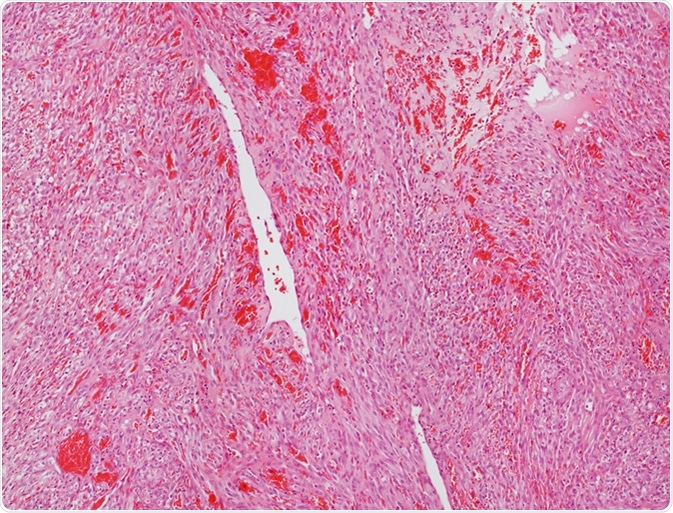Angiosarcoma Research

By Jeyashree Sundaram (MBA)
Angiosarcoma (AS) is a tumor of the soft tissue, which may occur in any part of the body. The classification of this type of sarcoma is generally based on the origin of tissue, but is mostly based on the molecular markers and the abnormality of chromosome.
Cutaneous angiosarcoma is the type of AS that occurs in the skin; nearly 60% of the angiosarcoma tumors that occur falls under this category. Additionally, 25% of angiosarcomas are soft tissue tumors. Very rarely, breast angiosarcoma occurs and accounts for about 8% of the tumor. Overall, 1–2% of sarcomas are angiosarcomas.

Research on Treatment for Angiosarcoma
ROCK inhibition
There are several treatments available for angiosarcoma, yet the common patient’s five-year survival is still low, approximately, accounting for up to 30% of cases. Giving anti-angiogenic medicine to the patient does not provide an efficient response. Due to this, much of current research is based on discovering new drugs for preventing the tumor progression.
A study for finding the drug that can act against the somatic mutations was conducted by testing the effectiveness of ROCK prevention against the angiosarcoma. This study proved successfully that ROCK2 is the first target for curing the angiosarcoma and os a target to study as a possible therapy.
Other Drugs
Newer drugs have been targeted at the blood vessels to act against the angiosarcoma, but the studies were not very clear in the earlier stages. During the year 2005–2006, many drugs were tested on patients targeting the area of the blood vessels that develop stimulator VEGF. The drugs included in this were SU11248, AMG706, and BAY43-9006.
In March 2005, this study was in the stage of planning, and testing was carried out in 2005–2006. The response of this antitumor drug in angiosarcoma patients was seen to be positive yet further research is required to study the extent of its use.
Research on Chemotherapy
In March 2016, a study regarding the development of a chemotherapy medication for angiosarcomas was published. In the study, the researchers found that a new drug named propranolol for treating blood pressure provides a strong chemo-boosting effect, when it is used along with a combination of some chemotherapeutic medicines for angiosarcoma treatment. It was concluded that the chemotherapy medicine, called vinblastine, works well in patients as it increased their length of life when used with the beta-blocker propranolol.
Research on Genetics of Angiosarcoma
MYC gene: Generally, angiosarcoma arises due to many reasons, which may sometimes also be genetic aberration. Three researchers namely, ‘Thomas krausz, Kristen M. Paral, and Gordana Raca’ published a study in November 2015 based on the status of MYC gene in an angiosarcoma patient at the site of the arteriovenous graft (AVG).
In this study, they found that the angiosarcoma in the AVG is related to immunosuppression, even though they had suggested that some other etiological factors also change in the blood flow. They did not investigate the complete nature of genetic abnormalities in this case. Yet the status of MYC amplification associated in AVG angiosarcoma is not fully described. The researchers reported the status of MYC amplification in one case.
PTPRB and PLCG1 gene: In 2014, a study was conducted to identify the specific gene mutations that cause angiosarcoma. At the time, researchers found that the tumor may arise secondarily to the chronic lymphoedema or an ionizing radiation. Earlier studies had mentioned the abnormal angiogenesis, which included the somatic mutation signaling genes as the key factor for tumor.
This study included analysis on the whole-exome, whole-genome, and targeted assembling for study of the somatic mutations to support the initial and secondary stages of angiosarcomas. Finally, they noted that the recurrent changes in two genes, such as PLCG1 and PTPRB, were related to angiogenesis. This finding provides better information for strengthening the present-day treatment efforts to aim at signals of angiogenesis in angiosarcoma patients.
NUP160-SLC43A3: During November 2015, a study was carried out to examine the exact gene that caused angiosarcoma. Researchers investigated the tumor cells taken from humans, in which they found that the new gene called NUP160-SLC43A3 is expressed more compared to other genes. They examined this gene in the tumor cells of 25 patients, among which tumors in 9 patients showed growth.
If the angiosarcoma tumor is due to this gene, it can result in the shortest duration between the first manifestation of symptoms and the first visit to the hospital; this means the progression of disease is very fast. They also found that the presence of fusion gene NUP160 in the ISO-HAS cells is weakened and reduced conversely by RNAi-mediation. Finally, although their findings provide better information for the advanced researches on the gene, the treatment and diagnosis for complete cure of tumor is still in the nascent stage of research.
Sources
- https://www.ncbi.nlm.nih.gov/pubmed/24633157
- https://www.hindawi.com/journals/cripa/2015/537297/
- https://www.ncbi.nlm.nih.gov/pubmed/26527604
- https://sarcoma.org.uk/sarcoma-types/angiosarcoma#toc-1
- www.mayoclinic.org/…/dxc-20323073
- http://www.nature.com/ng/journal/v46/n4/full/ng.2921.html
- https://www.ncbi.nlm.nih.gov/pmc/articles/PMC5364828/
Further Reading
- All Angiosarcoma Content
- What is Angiosarcoma?
- Angiosarcoma Treatments
- Angiosarcoma Symptoms and Causes
- Angiosarcoma Diagnosis
Last Updated: Feb 26, 2019
Source: Read Full Article